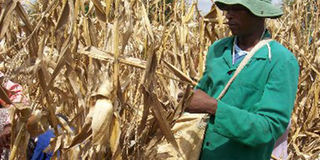Options now available for farmers to increase yields

A farmer harvest maize on his farm. PHOTO | FILE | NATION MEDIAN GROUP
What you need to know:
- The variety is resistant to two pests, including the stem borer, which takes away up to 400,000 tonnes of maize from Kenyan farmers annually.
- Maize is the most widely grown staple crop in Africa, yet drought and other adverse weather changes have in recent years ruined the crop leaving many households exposed.
- Our basic role, at AATF is to promote and facilitate public-private partnerships, which can access, deliver and adopt these technologies
- Under the WEMA project, 59 drought tolerant hybrids have been released, with one, WE1101 already commercialised in Kenya.
- We also have the StrigAway maize seed, which is resistant to the deadly striga weed, which is ravaging many parts of Kenya.
The application by the African Agricultural Technology Foundation and Kenya Agricultural and Livestock Research Organisation (Kalro) for the environmental release of genetically modified maize was recently approved by the government, the clearest indication yet that technology could soon be embraced in the country. Foundation executive director Dr Denis Kyetere spoke to JULIUS SIGEI on this and other technologies to boost production.
How soon are farmers likely to grow GM maize now that your application with Kalro for environmental release of GM seeds was recently approved by the government?
First, we at AATF believe that the African farmers need choices. We believe they need all the best technologies available to their counterparts in the rest of the world. But the choice is theirs. It now depends on how fast the regulatory authorities move, but we are optimistic that by next year it will be tested on people’s farms.
The variety is resistant to two pests, including the stem borer, which takes away up to 400,000 tonnes of maize from Kenyan farmers annually. In the current exchange rate, this is equivalent to Sh9 billion, which Kenya presently spends on maize imports.
Maize is the most widely grown staple crop in Africa, yet drought and other adverse weather changes have in recent years ruined the crop leaving many households exposed.
How can technology help?
Effects of drought are adverse because often it comes at the critical time, during germination and flowering stage.
Worse, it is not just an issue of moisture scarcity. It is the associated effects of pests and diseases that opens the crop to more damage. This is where technology comes in; to breed varieties which have short maturing periods. This makes them escape drought.
But some of these technologies are beyond the reach of many African farmers. What does it take to get these technologies into the hands of local farmers?
Partnerships. Our basic role, at AATF is to promote and facilitate public-private partnerships, which can access, deliver and adopt these technologies. For instance, under the Water Efficient Maize for Africa Project, we produced varieties that are resilient to drought.
They have capacity to enable farmers in drought-stricken areas to get up to 35 per cent more yields above the best commercial varieties in the market. Indeed some farmers are reporting up to 40 per cent increase in yields.
How widely available are these varieties?
They are available through local seed companies. Under the WEMA project, 59 drought tolerant hybrids have been released, with one, WE1101 already commercialised in Kenya. We also have the StrigAway maize seed, which is resistant to the deadly striga weed, which is ravaging many parts of Kenya.
Also known as witch weed, these parasitic weeds grow on the roots of host plants, absorbing the plants’ water and minerals.
They cause between 30 and 80 per cent loss in the farms which suffer infestation and they are difficult to control because they produce thousands of small and light seeds per plant that are easily and widely dispersed by wind, water, animals, and agricultural implements.
Our partnership with Kenya Seed and Freshco, has already seen some maize farmers get up to three times what they used to get.
Technology uptake in Africa is very low compared to the rest of the world. What needs to be done for this to change?
Market, for me, is the main driver. Farmers will choose what benefits them the most. But this also goes with awareness, and media is critical on that. Then we need financing to access the technologies and this is where partnerships come in.
We also need favourable policies such as those on land ownership and the recognition that technology is key. This will provide the favourable environment for technology uptake to thrive.





